In this topic I will show my 42 Calb Cam72 cell conversion. I used an Elcon 2500W charger and a Mini BMS system. The BMS main board is powered from the DC-DC converter, but during charging it is powered by a switching 12V power supply from the grid.
This is how the charger fits.
The cells are bedded in closed cell foam and have a snug fit in the frame. In this way 38 cells can be put in the bottom. Top right in the picture below an extra fuseholder can be seen for the charger DC wires. The DC charger wires are not going to the motorcontroler anymore but directly to the battery:
4 cell are on the "second floor". The bottom layer of cells have spacers and a polycarbonate sheet on top. The botom layer of cells are blocked on the top so they can't move up when riding over a bump or so.
The picture above is taken during the conversion (not ready). As you can see the 4 extra cell are wired in series with the bottom pack using the Original anderson connector. The fuse is not in the motorcontroller anymore (replaced by a copper strip) but "in the middle" of the pack. When it blows, it is simple to replace.
In the aluminium box is the BMS main board, the AC-12DC power supply and the solid state relay to switch off the charger when the BMS kicks in. In the other (plastic) box the Arduino for the SOC meter is housed (more on that later). As the HV wires of the 4 top cells could be rubbing the aluminium box, a piece of plastic is put in between to prevent short circuits (not shown on the picture).



As my V is a daily commuter and the roads are ofeten salted at this time of the year, I put rubber boots on the front forks. They protect the chrome and the seals. In the summer it's usefull as well, without the boots you van have flies/midgets sticking on the chrome and the fork seals rubbing over it. These boots come from a MZ ETZ250 motorbike (MZ is a former east German motorbike).
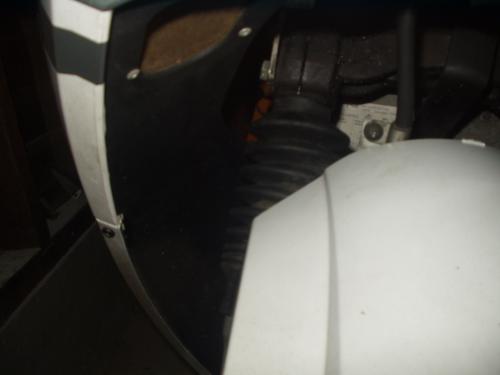
A flexible flap between the rear mudguard an rear fork help to reduce dirt spraying over the rear fork pivot points and the area where the motor wires enter the rear fork.
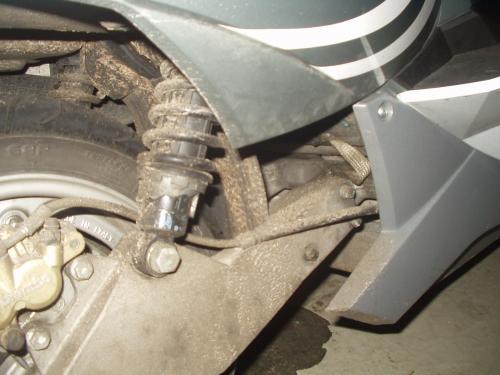
I cut off the flap attached to the trunk. It makes removing the battery lid difficult (yes, I should have done the cutting neater...). I put in 2 temperature gauges to monitor the temperature of the battery pack. The biggest reason for this was that LiFePO4 should not be charged below 0 degrees C.
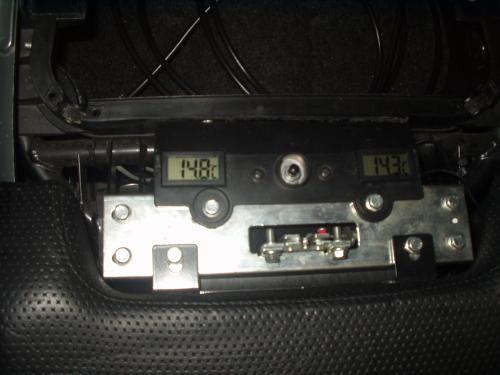
AND LiFePO4 is no good at anything above 1C when the cells are that cold. Any plans on heating the battery, as you seemingly are of the same all-year rider type as I am ? ;-)
My rides:
2017 Zero S ZF6.5 11kW, erider Thunder 5kW
I assume you mean below 1C? I don't agree with that. I've ridden my GBS cell equipped scooter at temperatures down to -6C or so without problems aside from a reduced top speed, but it still does 80 kph at least.
And assuming the CC-CV charge protocol or some approximation of it is used, then LiFePO4 cells can also be charged below freezing, the only problem will be that they will come up to the 3.56-3.7 volt switching voltage prematurely, and the CV or "balancing" part of charging will take a very long time.
This may be changing now that the pack is about 4-5 years old and has about 30K km on it. I got a low-voltage cutoff a couple times accelerating hard from a traffic light at -5C, and today in warmer +4C weather I was getting a high-voltage cutout when regen braking from 70-80 kph going down hill in spite of the pack being discharged a fair amount. The internal resistance is definitely increasing with age and while most of this is due to one cell that I know of, the whole pack may need replacing after the next warm season. It is going to take some diplomacy to convince my wife to let me take $2300 or so out of the "rainy day" fund for a new pack.
I assume you mean below 1C? I don't agree with that. I've ridden my GBS cell equipped scooter at temperatures down to -6C or so without problems aside from a reduced top speed, but it still does 80 kph at least.
And assuming the CC-CV charge protocol or some approximation of it is used, then LiFePO4 cells can also be charged below freezing, the only problem will be that they will come up to the 3.56-3.7 volt switching voltage prematurely, and the CV or "balancing" part of charging will take a very long time.
This may be changing now that the pack is about 4-5 years old and has about 30K km on it. I got a low-voltage cutoff a couple times accelerating hard from a traffic light at -5C, and today in warmer +4C weather I was getting a high-voltage cutout when regen braking from 70-80 kph going down hill in spite of the pack being discharged a fair amount. The internal resistance is definitely increasing with age and while most of this is due to one cell that I know of, the whole pack may need replacing after the next warm season. It is going to take some diplomacy to convince my wife to let me take $2300 or so out of the "rainy day" fund for a new pack.
No, I definitely mean LiFePO4 is not good below 0°C for anything higher than 1C. And interestingly you describe just that in the last paragraph. Even in the new state I got low-voltage cutoffs with a fully charged battery but 3-4C currents. And I have to climb out of a river valley every evening with a potentially cold-soaked battery that will shut down ride at even the most modest accelerator grip position. I have to crawl up that gradient at below 30km/h when my bike can easily shoot up there with over 60km/h (the legal limit there) when the battery is warm (above 20°C). And yes, the cell impedance increases with cell age (charge-discharge cycles), so the problem gets more and more pronounced over time.
I started out with heating the battery to 15°C, the next winter I had to increase that to 20°C, and now I am aiming at 20...25°C to ensure I have full usage of my ride.
My rides:
2017 Zero S ZF6.5 11kW, erider Thunder 5kW
Yes, but I'm only getting a low voltage cutoff with an aging pack and it is likely due to just one bad cell. Before this winter, I had no problems. And I still have no problems of the magnitude that you are experiencing. At below about -2 or so, I can't do full throttle acceleration from a stop, but the performance is still OK including up hills.
According to Calb specs the cells should not be charged below freezing. I have read something about lithium plating of an elektrode that can occur when charging below freezing (could this raise internal resistance?). But i am not a chemist, so I will just stick to what Calb says. I have no battery heating build in (I did do that with our electric car, a 1992 Fiat Panda Elettra concerted to LiFePO4) as the V is charged mainly in a garage. The garage is not heated but seldom below freezing inside. The Dutch circumstances are not very harsh. Hardly any hills to climb, hardly ever very cold.
The relative big capacity of my cells (72Ah) make that the discharge current is usually below 1C (although I have seen peaks of 210A so almost 3C). I have the impression that modern cells could have a lower internal resistance than somewhat older designs. When I got the Calb cam cells, I got a report of the cells stating the internal resistance and capacity per cell. In that same report there were test reports of CA180FI cells to. The 180Ah cells have internal resistances between 0.22 and 0.38 mOhms, the Calb Cams 72Ah between 0.31 and 0.34 mOhms (at 20 degrees Celcius). So the Calb Cams are good in terms of internal resistance: there is much less spread between cells in the internal resistance, and relative to the capacity they do better than the CA180FI. I am not sure, but that could be beneficial for low temperature performance.
I have been driving in about -5 degrees Celcius, and that did not give any problems. But time will tell when the pack gets older... I do not have the BMS connected to the motorcontroller, but four high brightness leds switch on when a cell reaches high or low voltage.
What year is your bike?
ESD or Runke original charger?
Originally Nimh or Li?
Original Software?
How do you measure the SOC?
(sorry for the repeated questions, it would be nice if all your good information is centralized in a single topic...).
Keep us posted and enjoy your new V!
My V is a late 2008 unit, model year 2009 (I think). I was surprised that it still had the 125A fuse. It had a ESD charger and it was a NiMH bike originally. The software is original, top speed limited to 100 km/h (62 MPH).
About the SOC measuring:
A SOC counter that I wanted did not exist (as far as I know...). So I build my own SOC meter based on a Arduino (my first Arduino project). I wanted the SOC simply shown in percent. Full pack 100%, when 80% of the nominal capacity is used, I want it to show 0% as I do not want to deplete the pack totally. I do not want to reset the SOC meter after each charge and it should take the regenerative braking into account. When switching the Vectrix off, I want it to store the SOC of that moment, and when switching the V on again I want it to start with that stored SOC. Next to that it should work without a 12V auxilary battery, as the V does not have that.
This is what it looks like on the V:
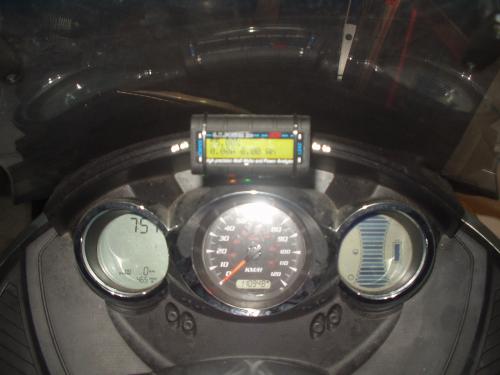
Main thing it gives the SOC in %, but it also gives the amp drawn from the pack (or going into the pack) and the amphours consumed since the V is switched on. I used the amphours reading for debugging, but decided to keep this on the screen. The LCD screen is mounted in a housing of a defect RC wattmeter ;-). Next to the SOC meter you see two leds on each side, they light up when the BMS sees a high or low voltage event.
During driving the Arduino/LCD is powered from the Vectrix DC-DC converter. I tapped the 12V close to the trunk light switch. During charging it is powered from a small ac mains to DC 12V power supply (that also feeds the BMS main board). When the power to the Arduino is switched off, it senses a low voltage on a input pit, that tells it to store its SOC value, but for doing that the Arduino is powered just long enough from some capacitors. This is the scheme:

The current sensing is done by a hall effect current sensor, as I like the the SOC meter to be seperate from the battery pack of the V. I used a Tamura L01Z200S05 sensor.
I am not into electronics very much and for sure not a programmer, so I think the thing/code could be improved by experienced people, but at least it works for me and very reliable. The current sensor could use some filtering (either using discrete components or by programming)as the amp reading is not very stable.
I will put the Arduino code with additional information in the next post.
This is the Arduino code with some additional information. I would suggest: have a look at the Arduino site, and first try to get the "LiquidCrystal Library - Blink" example going before starting this project.
edit:
Please note: when I uploaded this post I noticed that some things between () changed! So if you want the code, please give me a PM or so.
/*
This is a SOC (state of charge) meter using a hall efect sensor.
With the sensor stated further, currents up to 250A (300?) can
be measured. Discharging and charging is taken into account for
the SOC.
Because the charging efficiency is not taken into account (100%
charge and discharge efficiency) the SOC will always come back to
100%. In reality the (dis)charging efficiency is never 100%. Therefore
always more Ah flows in than out the battery. When the SOC reaches 100% it will
not raise above 100%. A reset after charging is therefore not necessery.
This project was originally done for a Vectrix electric motorscooter
converted to LiFePO4 batteries with a usable capacity of 57Ah (80% of 72Ah).
The code was put in the code of the LiquidCrystal Library - Blink.
LiquidCrystal Library - Blink
Use a 16x2 LCD display. The LiquidCrystal
library works with all LCD displays that are compatible with the
Hitachi HD44780 driver. There are many of them out there, and you
can usually tell them by the 16-pin interface.
The circuit:
* LCD RS pin to digital pin 12
* LCD Enable pin to digital pin 11
* LCD D4 pin to digital pin 5
* LCD D5 pin to digital pin 4
* LCD D6 pin to digital pin 3
* LCD D7 pin to digital pin 2
* LCD R/W pin to ground
* 10K resistor:
* ends to +5V and ground
* wiper to LCD VO pin (pin 3)
Library originally added 18 Apr 2008
by David A. Mellis
library modified 5 Jul 2009
by Limor Fried (http://www.ladyada.net)
example added 9 Jul 2009
by Tom Igoe
modified 22 Nov 2010
by Tom Igoe
This SOC meter displays SOC, Current (A) and Ah consumed.
The sensor used is a Tamura L01Z200S05. The sensor ground
is connented to ground at the arduino board.
The sensor voltage supply is connected to 5V on the
Arduino board.
The sensor output is connected to analog pin 0.
There should be a resistor of 10K between sensor output
and ground.
The arduino is programmed to store the SOC when power is shut down.
To do that, a 12V power suply is used. In the + lead a diode is put in series.
Parallel to the arduino board at the cathode side of the diode there are
three capacitors of each 2200 uF.
At the anode side of the diode the voltage is sensed. Using a zener diode in
series with a resistor to ground, voltage at the zener-resitor connection can be
sensed at digital pin 7.
When the power suply goes down, first the digital pin 7 senses "low" while the
capacitors can still feed the arduino to store the SOC in the eeprom.
It is wise to use a resistor in series with the sense wire and a zener of 4.7V
clamped to ground. Reason: the voltage of digital pin 7 may never exceed 5V.
*/
// include the library code:
#include
// include eeprom:
#include
// initialize the library with the numbers of the interface pins
LiquidCrystal lcd(12, 11, 5, 4, 3, 2);
int ledPin = 13; //pin 13 used for power supply LCD screen
int inPin = 7; // shut off voltage on pin 7
int volt = HIGH; // variable to store the read value of pin 7
int analogPin = 0;
//potmeterwiper on pin 0
int val = 0;
//variable to store the value read; val is de ad value
float A = 0.0;
//variable to store the value read; A is the current
float Ah = 0.0;
//variable to store the value read; Ah is ampere times hour during 1 loop
float totalAh = 0.0;
//variable to store the total amount of Ah consumed
float SOC = 0;
void setup() {
pinMode(ledPin, OUTPUT); // sets the digital pin as output
digitalWrite(ledPin, HIGH); // put 5V on pin 13
delay(500);
// set up the LCD's number of columns and rows:
lcd.begin(16, 2);
// Print a message to the LCD.
lcd.print("SOC meter");
delay(1000);
pinMode(inPin, INPUT); // sets the digital pin 7 as input
SOC = EEPROM.read(0);
SOC = SOC+1; //needed else the SOC would drop 1% each time the "ignition" is switched on
if (SOC > 100) SOC = 100;
if (SOC < 0) SOC = 0;
}
void loop() {
// set up the LCD's number of columns and rows:
lcd.begin(16, 2);
// read the analog pin, "val" is the analog pin number:
val = analogRead(analogPin);
// convert the read value to the current. 2.5V is 0A,
// 1V is -200A (=charging), 4V is 200A (decharing battery)
// value 512 sets the zero current point. To ensure the SOC will be 100% after a charge choose the number a bit high.
// In that case the SOC meter is always seeing more energy flowing into the battery than flows out.
A = (val-512)/1.535;
//calculate the Ah consumed during 1 loop; for the arduino uno 1 loop took 14/100000 hour.
Ah = (A*14/100000);
//calculate the total Ah consumed
totalAh = (A*14/100000)+totalAh;
//calculate the SOC in (%)of the battery capacity
//usable capacity is 57Ah
SOC = SOC-((Ah*100)/57);
if (SOC > 100) SOC = 100;
if (SOC < 0) SOC = 0;
// print SOC on the screen
lcd.setCursor(0,0); // set cursor to column 0, row 0 (the first row)
lcd.print(SOC);
lcd.print("% ");
// Print the current on LCD:
lcd.setCursor(0,1); // set cursor to column 0, row 1
lcd.print(A);
lcd.print("A ");
// Print the Ah on LCD:
lcd.print(totalAh);
lcd.print(" Ah ");
delay(500);
volt = digitalRead(inPin); // read the input pin
if (volt == LOW) {EEPROM.write(0, SOC); //if suply voltage on pin 7 is low
//then store the SOC value
lcd.setCursor(0,0); // set cursor to column 0, row 0 (the first row)
lcd.print("store SOC");
delay(30000);} //wait several seconds so the whole arduino is shut down due too low voltage
}
"BUMP"
It has been a while since I wrote here. The V does its job, but lately the range suffered. So I drove until my BMS gave a low voltage warning en then I measured the open cell voltage of the cells. It was very clear that 1 cell was much lower than the other cells. I charged it again and it was that same cell that gave a high voltage BMS alarm.
I tested the capacity of the weak cell at 1C. The result: 48Ah (The Calb Cam is sold as 72Ah nominal, probably at 0.3C?). Another used cell randomly chosen from my V gave 69 Ah. I bought a brandnew cell and tested that. This cell gave 68Ah. A bit less than the healthy used cell!
So, on the one hand I am dissapointed that after only 25000 km a cell misses so much capacity. On the other hand it is clear that a 25000 km old healthy cell has still a capacity close to the nominal capacity. Is that broken cell just bad luck or will the other cells go bad one by one? Time will tell. Until now I have never had this kind of trouble with the Calb CA 100 Ah cells in our car.
The damaged cell is the one next to the motorcontroller? can you mark in the picture which one is failing?
This was the defect cell:
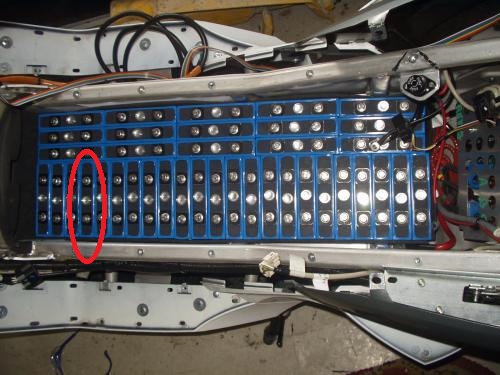
Here are the testresults from 5 Calb cam 72FI batteries:
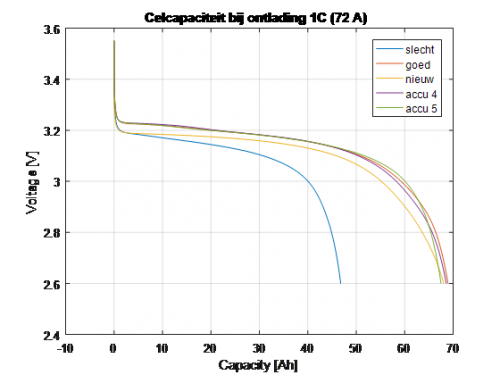
The bleu line is from the defect cell, the yellow line is the brand new cell, the other lines are from some other (good) cells used in the V (year 2014 cells). Two of those cells I had doubts about, but apear to be good (enough).
Each cell tested was charged cccv prior to the capacity test. CC mode with 25A, CV until 3.55V 1A. Discharge was 72A until 2.6V was reached. The cel temperature at the start of the charging was in the order of 20 degrees celcius. The cell temperature was not measured during the test.
It shouldn't have failed, the position is not to exposed to heat or structural stress. Please compare real voltages of all cells with BMS reportedvoltages. The BMS is reading voltages correctly?
What tool do you use to graph the capacity of each of your cells. I should get around to pulling my bad cells as my packs are getting old too. I am getting the battery light on even though the one bike seems to run fine, so I am sure things are going to get worse fast.
-Randy
______________________
I also own a 2018 Tesla Model 3 and a 2012 Mitsubishi iMiev
@ zwrtw: Internal resistance is the magic villain that causes a certain cell to seem to be empty much sooner than other cells with less internal resistance, and likewise will seem to be full much sooner than healthier cells due to undue voltage rise during the charge, again because of the higher inernal resistance.
That is most easily gauged by measuring open circuit voltage before test, then apply a known load (10A should do the job for a CAM 72Ah) while measuring mean voltage over 10 seconds, then unload the cell and let it rest for a minute or two and remeasure open circuit voltage.
Take the mean of before and after open circuit voltage, subtract mean voltage under the load, and divide the resulting voltage drop by the discharge current. This will give you an apparent resistance.
Repeat with a seemingly healthy cell and be amazed at the difference of voltge drop at the same load :-)
High operating / storage temperatures inside a cell cause electrolyte degradation, and the higher the ensuing internal resistance gets, the hotter the cell gets at a given load. And so on and so on...
My rides:
2017 Zero S ZF6.5 11kW, erider Thunder 5kW
Every so often I see a mystery failure from a cell
Most likely it's a manufacturing defect that couldn't be identified during Quality Control
Your pack is young, the rest should just slowly fade away as they age
Every so often I'll hear of a customers battery where a cell inexplicably has lost significant capacity, usually in the first 2-300 cycles.
at 25'000km, you'd still be around 200 cycles equivalent.
Curiously, the cell that lost capacity, doesn't tend to lose more, when cycled significantly more.
My TS 60Ah cells - the weakest is down to 44Ah (after 7 years and 120'000km/1300 cycles).
That same weakest cell had 47Ah capacity 5 years ago (at 600 cycles). I should capacity test the rest at some point
My usual solution is to just bypass the weak cell and carry on (minimum cell count on a vectrix is 39. If you start with 42, you can bypass up to 3 before having to actually get replacements)
Daily Ride:
2007 Vectrix, modified with 42 x Thundersky 60Ah in July 2010. Done 194'000km
Thanks for the replies!
@R: I agree, the cell should not have failed. The BMS is working correct. I checked that.
@Israndy: I work at a school for automotive engineering. There we have a test setup for batteries. This test setup logs things like voltage, current and time. A colleague of mine made a Matlab script to make those graphs.
@MEroller: that would be a nice test to perform. In the graph above you can see that the voltage of the weak cel and the new cel is lower than the others under the same load. This would indicate a higher inernal resistance of the weak and the new cell.
@Antiscab: I hope and think that you are right. Just bad luck with one cell. When I take the cells of our car and the Vectrix together, the failure rate of the cells is less than 1%. That is not too bad. Knock on wood that the failure rate does not go up. I replaced the bad cell and two suspicious cells with new cells and those suspicious cells were not bad after all. So I have two cells in reserve for the Vectrix. According to Murphy's law the cells in the V will remain good due to the reserve cells laying around ;-)
To have just one cell fail prematurely out of 42 cells actually shows that Chinese manufacturing QC is definitely improving!
The 2010 or 2011 GBS cells in my scooter had three premature failures out of just 24 cells over the first 2 years of use. They were replaced and since then, the remaining cells continue to do well at about 50K km - but are showing their age in the form of lots of internal resistance in cold weather.